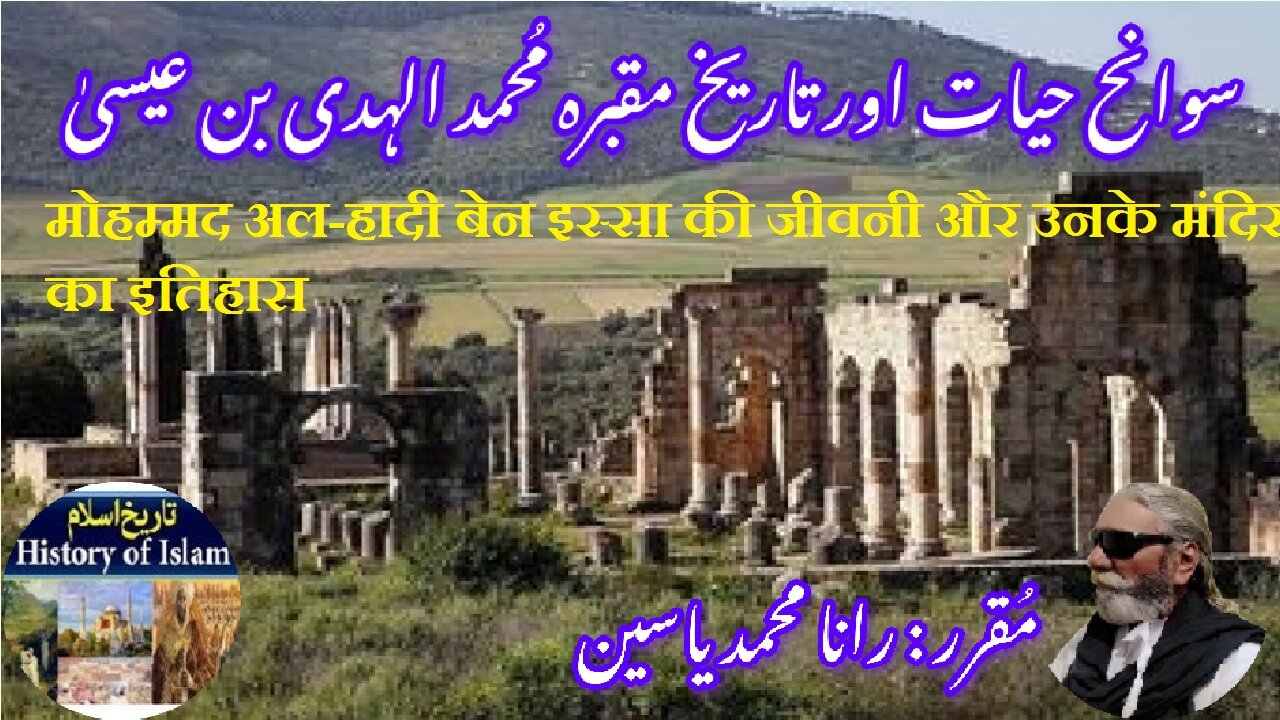Premium Only Content

Mohammed al-Hadi ben Issa | अल-हादी बेन इस्सा | محمد الہدی بن عیسی کی سوانح عمری اور مزار کی تاریخ
@islamichistory813 #mohammedalhadibenissa #sufisaint #culturalheritage #biography #islamicmysticism #islamicphilosophy #shrine #historicalfigures
Biography of Mohammed al-Hadi ben Issa and the history of his shrine
Dekhti Aankhooon aur sountay kaanoon ko Asslamoalaikum, sisters, brothers friends and elders, in informative series videos of Islamic ascolars, sufisaints, cultural heritages, islamic philosophys, islamic mysticisms and historical figures. today we are describing biography of Mohammed al-Hadi ben Issa and the history of his shrine.
Mohammed al-Hadi ben Issa (1467–1526), also known by his title Al-Shaykh al-Kamil, was a prominent Moroccan scholar of Sufism and an ascetic. His life and work have had a profound influence on the development of Islamic mysticism, particularly in North Africa. Al-Shaykh al-Kamil is best remembered as the founder of the Isawiyya Sufi order, which became one of the most significant Sufi movements in Morocco.
Mohammed al-Hadi was born in 1467 in the region of Tafilalt in southern Morocco, a historically significant area known for its deep connection to Islamic scholarship and spirituality. His family was well-established in the region, and his upbringing was steeped in the religious traditions of Islam. From a young age, al-Hadi showed a keen interest in spiritual matters, and his early education focused on Islamic jurisprudence, theology, and mysticism.
Al-Hadi was particularly drawn to the Sufi path, which emphasized the inner dimensions of spirituality, such as devotion to God, self-purification, and the cultivation of a deep, personal relationship with the Divine. Sufism provided him with the means to transcend the material world and pursue a more profound connection with God. His ascetic lifestyle, which involved renunciation of worldly comforts and a focus on spiritual practices like prayer, fasting, and meditation, became a hallmark of his character.
Al-Hadi's spiritual journey eventually led him to found the Isawiyya Sufi order, a movement that sought to bring people closer to God through mystical practices, self-discipline, and devotion. The Isawiyya order emphasized simplicity, humility, and the importance of internal purification. Al-Hadi's teachings focused on the concept of divine love and the necessity of transcending one's ego in order to attain spiritual closeness to God. The order became known for its emphasis on the individual's direct experience of the Divine and its rejection of materialism and worldly attachments.
The Isawiyya order was distinct for its unique blend of rigorous asceticism and deep mysticism. Al-Hadi's followers, or "Isawis," practiced regular recitation of dhikr (remembrance of God) and meditation as part of their spiritual regimen. Al-Hadi's leadership was instrumental in spreading the teachings of the Isawiyya order across Morocco and beyond, and the order attracted a large following of individuals seeking a deeper connection with God through the practices of Sufism.
Al-Hadi al-Shaykh al-Kamil spent much of his life traveling and teaching, spreading the principles of his Sufi order throughout Morocco. He was highly regarded for his wisdom, piety, and spiritual insight. His reputation as a scholar and mystic grew, and he became known for his personal devotion to ascetic practices, which inspired many of his followers.
Al-Hadi passed away in 1526, marking the end of an era for the Isawiyya order. He died in the city of Fes, a major center of Islamic learning and spirituality in Morocco, where he had spent much of his life. His death was deeply mourned by his followers, who saw him not only as a spiritual leader but also as a guide who had shown them the path to divine closeness.
After his death, Mohammed al-Hadi al-Shaykh al-Kamil's legacy continued through the Isawiyya order, which remained influential in Morocco and other parts of North Africa. The order is still active today, with numerous followers who continue to adhere to his teachings of asceticism, mysticism, and the pursuit of divine love.
Al-Hadi's shrine is located in Fes, Morocco, and it has become a significant site of pilgrimage for his followers and others seeking spiritual guidance. The shrine, known for its serene and tranquil atmosphere, is visited by countless pilgrims who come to pay their respects and seek blessings. Visitors often pray and recite prayers of devotion to honor Al-Hadi’s life and teachings.
The site of his shrine has become a symbol of his enduring influence, both as a scholar and as a spiritual leader. It represents the ongoing importance of Sufism in Moroccan religious life and the continued relevance of Al-Hadi’s teachings in the modern world. His life and legacy continue to inspire those who seek a deeper understanding of spirituality and the path to closeness with God through Sufism.
With this, we seek your permission until tomorrow, tomorrow we will describe the biography of Khawaja Gharib Nawaz and the history of his Shrine.
======================
-
 7:51
7:51
ISLAMIC HISTORY
23 hours agoWhat are the signs of a hypocrite in Islam اسلام میں منافق کی نشانیاں کیا ہیں؟
1 -
 13:25
13:25
The Gun Collective
13 hours agoWOW! A LOT of new GUNS just dropped!
5054 -
 LIVE
LIVE
BEK TV
22 hours agoTrent Loos in the Morning - 9/04/2025
334 watching -
 8:13
8:13
Geoff_Tac
1 day agoMAC 1014 Shotgun (Benelli Clone)
522 -
 22:30
22:30
Ohio State Football and Recruiting at Buckeye Huddle
12 hours agoOhio State Football: How Matt Patricia Confused Arch Manning and Texas
2.77K -
 9:07
9:07
MattMorseTV
17 hours ago $3.61 earnedTrump just BLASTED the CCP.
22.6K45 -
 58:44
58:44
The Official Corbett Report Rumble Channel
11 hours agoTurning the Tide on 9/11 with Curt Weldon
3.9K15 -
 10:47
10:47
Nikko Ortiz
15 hours agoThese Tik Tok Clips Are Extremely Painful...
17.4K3 -
 8:12
8:12
VSOGunChannel
18 hours ago $0.43 earnedATF Still Wants to Take Your Incomplete Guns
2.44K8 -
 44:06
44:06
Esports Awards
17 hours agoUber: The Voice of Overwatch, VALORANT & Esports’ Biggest Moments | Origins Podcast #27
1.52K